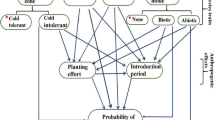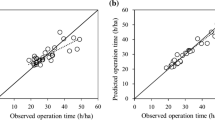Abstract
In this study, a weeding-duration model for Larix kaempferi plantations was developed that employs a generalized linear model. The number of years that weeding is necessary is the response variable, and elevation, slope, maximum snow depth, annual precipitation, geological type, soil type, site index, slope aspect, and vegetation type are explanatory variables. Among the explanatory variables, geological type, soil type, slope aspect, and vegetation type are categorical data. We assumed a Poisson distribution for the response variable. The link function was log. Among the models that could be developed from these variables, we chose the model with the smallest Akaike’s information criterion (AIC). The weeding-duration model can be written as follows: years that weeding is necessary = Exp (−0.0172833 × site index + 0.0014053 × maximum snow depth (cm) + 1.7417731). The results of this study imply that weeding of Larix kaempferi plantations is needed for more years as the maximum snow depth increases and fewer years as the site index increases. This model is useful for cost–benefit analyses of afforestation or reforestation with Larix kaempferi.




Similar content being viewed by others
References
Faraway JJ (2006) Extending the linear model with R: generalized linear, mixed effects and nonparametric regression models. Taylor & Francis Group, Boca Raton, 301 pp
Forest Development Division (1998–2009) Results of reforestation and afforestation work (in Japanese). Department of Fisheries and Forestry, Hokkaido Government, Sapporo
Forest Development Division, Department of Fisheries and Forestry, Hokkaido Government (2010) Standard unit prices for reforestation and afforestation work (in Japanese). Available from http://www.pref.hokkaido.lg.jp/sr/srs/0205.htm. Accessed 6 Aug 2010
Geographical Survey Institute, Ministry of Land, Infrastructure, Transport and Tourism (2010) Numerical value map—50 m mesh (elevation) (in Japanese). Geographical Survey Institute, Tokyo, CD-ROM
Hokkaido Branch, Forestry and Forest Products Research Institute (1983) Distribution map of the Sasa group in Hokkaido (in Japanese). Hokkaido Branch, Forestry and Forest Products Research Institute, Sapporo, 36 pp
Hokkaido Forestry Research Institute (2007) Forest practices system for plantations of Japanese larch (in Japanese). Hokkaido Forestry Research Institute, Bibai, 91 pp
Hokkaido Forestry Seeds and Seedling Association (2001–2010) Price list of forestry seedlings (in Japanese). Hokkaido Forestry Seeds and Seedling Association, Sapporo
Hokkaido Regional Forest District Office (1981) Distribution and characteristics of Sasa in Hokkaido Regional Forest District (in Japanese), Hokkaido Regional Forest District Office, Sapporo, 59 pp
Japan Meteorological Business Support Center (2010) Mesh Meteorological data 2000 (in Japanese). Japan Meteorological Business Support Center, Tokyo, CD-ROM
Land Greenery Committee Incorporated Association (1986) Forest vegetation of Hokkaido—weeds and herbs (in Japanese). Land Greenery Committee Incorporated Association, Sapporo, 370 pp
National and Regional Planning Bureau, Ministry of Land, Infrastructure, Transport and Tourism (2010) Land data information download service (in Japanese). Available from http://nlftp.mlit.go.jp/ksj/old/cgi-bin/_kategori_view.cgi. Accessed 14 June 2010
Nishiwaki A, Konno Y (1989) Evolutional significance on the difference of bud position between Sect. Sasa and Sect. Crassinodi (Genus Sasa). Bamboo J 7:11–17 (in Japanese with English summary)
Nogami K (1989) IV 2. Silviculture up to crown closure. In: Tsutsumi, T et al. (eds) New edition Silviculture (in Japanese). Asakurashoten Corporation, Tokyo, pp 158–171
Quinn GP, Keough MJ (2002) Experimental design and data analysis for biologists. Cambridge University Press, Cambridge, 537 pp
Acknowledgments
We thank Mr Takashi Deguchi of the Hokkaido government who provided the data on applications for afforestation and reforestation subsidies. We also thank an editor and two anonymous referees of this journal for very useful comments on the manuscript.
Author information
Authors and Affiliations
Corresponding author
About this article
Cite this article
Nakagawa, M., Kanno, M. & Yasaka, M. A weeding-duration model for Larix kaempferi plantations in Hokkaido, northern Japan. J For Res 16, 319–324 (2011). https://doi.org/10.1007/s10310-010-0228-3
Received:
Accepted:
Published:
Issue Date:
DOI: https://doi.org/10.1007/s10310-010-0228-3




